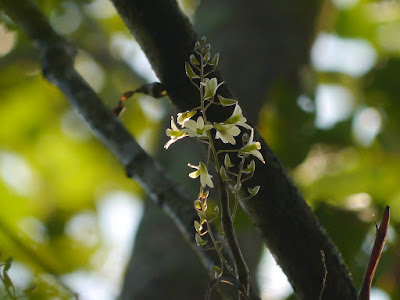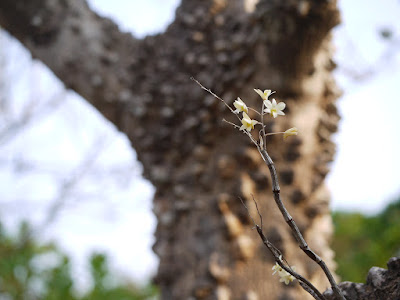Dendrobium ovatum is native to Western India. It grows in Western Ghats, and also Tamil Nadu at elevations of 50 to 1520 meters above sea level.
Dendrobium ovatum also called as Green Lipped Dendrobium, The Ovate Dendrobium, Callista ovata, Cymbidium ovatum, Dendrobium chlorops, Epidendrum ovatum, is a species of the genus Dendrobium. This species was described by Friedrich Fritz Wilhelm Ludwig Kraenzlin in 1910.
IDENTIFY DENDROBIUM OVATUM ORCHID PLANT
Dendrobium ovatum is native to Western India. It grows in Western Ghats, and also Tamil Nadu at elevations of 50 to 1520 meters above sea level.
It is a mini-miniature to medium sized, hot to cool growing epiphyte with 5-50 cm long, elongate, mauve-brown, terete to often stout stems carrying many, deciduous, oblong-lanceolate, alternate, acute, 5-10 cm long leaves.
Green Lipped Dendrobium blooms in the fall on a lateral, 15 cm long, several to many flowered, sub-corymbose inflorescence arising from the side or near the apex of the stem with minute, triangular, acute floral bracts. The flowers are cream colored, with a green center. Sepals and petals are 7-10 mm long. Lips is 7-8 mm long, 3-lobed. Lateral lobed are small, erect, while the mid lobe is longer, hanging out, covered with green soft hairs.
DENDROBIUM OVATUM ORCHID PLANT CARE AND CULTURE
Cultural information should only be used as a guide, and should be to be adapted to suit you. Your physical location; where you grow your plants, how much time you have to devote to their care, and many other factors, will need to be taken into account. Only then can you decide on the cultural methods that best suit you and your plants.
Light:
Dendrobium ovatum like plenty of light, but cannot stand the full noonday rays of the sun (15000-40000 lux, filtered or diffused light is recommended.). These usually do best when placed so that they can get the early morning sun, but are shaded from about 10 a.m. onwards in the Summer time. In the Winter they can usually stand the sun's rays up to 11.30 a.m.
Temperature:
The average temperature of the summer day is 30-32 ° C, night 22 ° C, giving a daily difference of 8-9 ° C. In winter the average day temperature is 28-31 ° C, night 11-13 ° C, giving a daily difference of 15-18 ° C.
Humidity:
From summer to autumn, Green Lipped Dendrobium need the humidity of 80-85%, but for most of the remaining period it drops to 60-70%.
Too dry air has a negative effect on the development of the plant: its growth is inhibited, and the leaves begin to turn yellow and dry out. The higher temperature, the higher the humidity should be, and the higher the humidity, the more often and longer it is necessary to ventilate the room where the plants are contained, otherwise the probability of rotting and various kinds of fungal diseases.
Substrate, growing media and repotting:
Dendrobium ovatum grows best in wooden baskets with staghorn peat as substrate (line the bottom with a few large pieces of wood-charcoal, which helps to provide aeration, and counteracts any tendency of the compost to ferment). The pseudobulbs can be tied, where necessary, to the hanging wires, thus ensuring stability.
It does not need frequent repot, therefore, it is desirable to transplant only when it is really necessary, for example, in cases of strong salinization or compaction of the substrate, at its critically high or low pH (the norm is from 5.5 to 6.5) or when the plant grows very strongly and the pot becomes cramped to it (pseudobulbs begin to hang from the edges of the pot). Repotting is best done immediately after flowering when new roots and new growth begin to grow.
Watering:
The Ovate Dendrobium will require heavy watering until well into the Autumn, the plants then being allowed to dry out for the Winter, except for a soaking about once in four to six weeks.
Watering is directly dependent on the temperature of the content, the higher it is, the more often it needs to be watered. When watering, excess water should flow freely from the pot, since stagnation of water both inside the pot and in its pan can very quickly lead to rotting of the roots and the lower part of the plant.
Fertilizer:
It is recommended to use a 1/4-1/2 dose of orchid fertilizer weekly. You can use the balanced fertilizer throughout the year or from spring to mid-summer use high-nitrogen fertilizer, and then until the end of autumn high-phosphoric fertilizer to stimulate flowering.
Rest period:
Dendrobium ovatum need less water in the winter, especially if they grow under the conditions of a dark, short day that occurs at moderate latitudes. They should dry somewhat between waterings, but they should not be dry for a longer period. Frequent morning fogging and rare, economical watering should allow the plant to go through a dry period of rest, while providing it with sufficient humidity. Fertilization should be reduced or eliminated until new growths appear and a more abundant spring watering begins.















COMMENTS